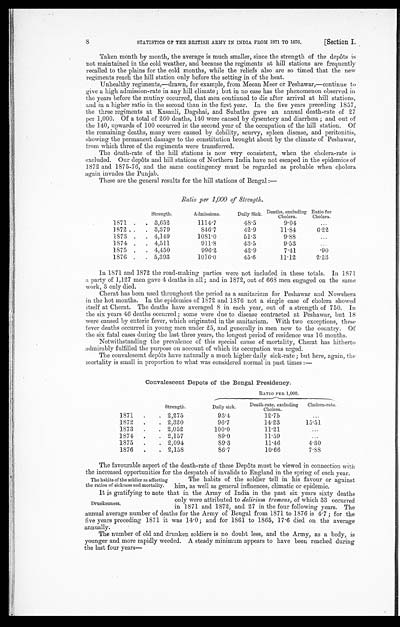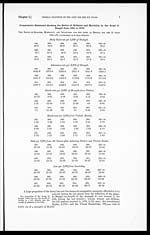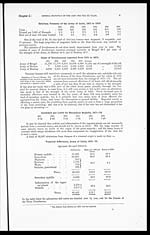Medicine - Institutions > Army health reports and medical documents > Vital statistics of India. Vol. V, Reports of 1876 on armies & jails and on epidemic cholera > Section I - General statistics of the British Army of India, 1871-76 > Chapter I - General statistics of sickness and mortality during the six years from 1871 to 1876
(28) Page 8
Download files
Individual page:
Thumbnail gallery: Grid view | List view

8
STATISTICS OF THE BRITISH ARMY IN INDIA FROM 1871 TO 1876.
[Section I.
Taken month by month, the average is much smaller, since the strength of the depôts is
not maintained in the cold weather, and because the regiments at hill stations are frequently
recalled to the plains for the cold months, while the reliefs also are so timed that the new
regiments reach the hill station only before the setting in of the heat.
Unhealthy regiments,—drawn, for example, from Meean Meer or Peshawar,—continue to
give a high admission-rate in any hill climate; but in no case has the phenomenon observed in
the years before the mutiny occurred, that men continued to die after arrival at hill stations,
and in a higher ratio in the second than in the first year. In the five years preceding 1857,
the three regiments at Kasauli, Dagshai, and Subathu gave an annual death-rate of 27
per 1,000. Of a total of 260 deaths, 140 were caused by dysentery and diarrhœa; and out of
the 140, upwards of 100 occurred in the second year of the occupation of the hill station. Of
the remaining deaths, many were caused by debility, scurvy, spleen disease, and peritonitis,
showing the permanent damage to the constitution brought about by the climate of Peshawar,
from which three of the regiments were transferred.
The death-rate of the hill stations is now very consistent, when the cholera-rate is
excluded. Our depôts and hill stations of Northern India have not escaped in the epidemics of
1872 and 1875-76, and the same contingency must be regarded as probable when cholera
again invades the punjab.
These are the general results for the hill stations of Bengal:—
Ratio per 1,000 of Strength.
| Strength. | Admissions. | Daily Sick. | Deaths, excluding Cholera. |
Ratio for Cholera. |
|||
| 1871 | . | . | 3,652 | 1114.7 | 48.5 | 9.04 | ... |
| 1872 | . | . | 3,379 | 846.7 | 42.9 | 11.84 | 6.22 |
| 1873 | . | . | 4,149 | 1081.0 | 51.3 | 9.88 | ... |
| 1874 | . | . | 4,511 | 911.8 | 43.5 | 9.53 | ... |
| 1875 | . | . | 4,450 | 996.2 | 42.9 | 7.41 | .90 |
| 1876 | . | . | 5,393 | 1016.0 | 45.6 | 11.12 | 2.23 |
In 1871 and 1872 the road-making parties were not included in these totals. In 1871
a party of 1,127 men gave 4 deaths in all; and in 1872, out of 668 men engaged on the same
work, 3 only died.
Cherat has been used throughout the period as a sanitarium for Peshawar and Nowshera
in the hot months. In the epidemics of 1872 and 1876 not a single case of cholera showed
itself at Cherat. The deaths have averaged 8 in each year, out of a strength of 750. In
the six years 46 deaths occurred; some were due to disease contracted at Peshawar, but 18
were caused by enteric fever, which originated in the sanitarium. With two exceptions, these
fever deaths occurred in young men under 25, and generally in men new to the country. Of
the six fatal cases during the last three years, the longest period of residence was 16 months.
Notwithstanding the prevalence of this special cause of mortality, Cherat has hitherto
admirably fulfilled the purpose on account of which its occupation was urged.
The convalescent depôts have naturally a much higher daily sick-rate; but here, again, the
mortality is small in proportion to what was considered normal in past times:—
Convalescent Depots of the Bengal Presidency.
| RATIO PER 1,000. | ||||||
| Strength. | Daily sick. | Death-rate, excluding Cholera. |
Cholera-rate. | |||
| 1871 | . | . | 2,275 | 93.4 | 12.75 | ... |
| 1872 | . | . | 2,320 | 96.7 | 14.23 | 15.51 |
| 1873 | . | . | 2,052 | 100.0 | 11.21 | ... |
| 1874 | . | . | 2,157 | 89.0 | 11.59 | ... |
| 1875 | . | . | 2,094 | 89.3 | 11.46 | 4.30 |
| 1876 | . | . | 2,158 | 86.7 | 10.66 | 7.88 |
The habits of the soldier as affecting
the ratios of sickness and mortality.
The favourable aspect of the death-rate of these Depôts must be viewed in connection with
the increased opportunities for the despatch of invalids to England in the spring of each year.
The habits of the soldier tell in his favour or against
him, as well as general influences, climatic or epidemic.
Drunkenness,
It is gratifying to note that in the Army of India in the past six years sixty deaths
only were attributed to delirium tremens, of which 33 occurred
in 1871 and 1872, and 27 in the four following years. The
annual average number of deaths for the Army of Bengal from 1871 to 1876 is 4.7; for the
five years preceding 1871 it was 14.0; and for 1861 to 1865, 17.6 died on the average
annually.
The number of old and drunken soldiers is no doubt less, and the Army, as a body, is
younger and more rapidly weeded. A steady minimum appears to have been reached during
the last four years—
Set display mode to: Large image | Zoom image | Transcription
Images and transcriptions on this page, including medium image downloads, may be used under the Creative Commons Attribution 4.0 International Licence unless otherwise stated. ![]()
| Permanent URL | https://digital.nls.uk/74993349 |
|---|




